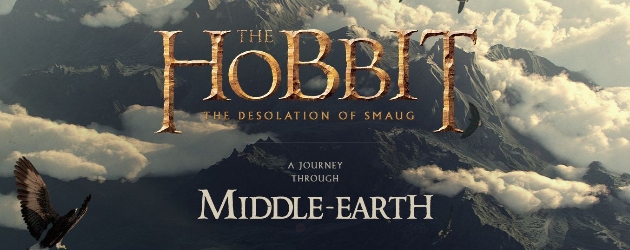
Peter Jackson’s Lord of the Rings and Hobbit trilogies cover a lot of territory, and not just metaphorically speaking. Middle-earth is a vast land that harbors all sorts of unique locales which are usually only touched upon in the films. Seeing as the crux of both trilogies relies heavily on our own knowledge of where we have been and where we will soon be going, it seems only natural to have a guide to keep track of the immense world that J.R.R. Tolkien has created.
So, with the release of The Hobbit: The Desolation of Smaug closing in, New Line Cinema and Google have partnered up to give us an interactive guide into the world of Middle-earth unlike any other. Not only filled with useful information on its inhabitants, the guide also provides some unique ways of immersing yourself into Middle-earth that goes beyond just a simple mapping system. Get more details after the break.
Google Chrome Experiments have been promoting and showcasing a number of diverse projects by creative individuals for a while now. But this latest experiment, which you can experience first hand by clicking this link, is more than just some tech demo or proof of concept. With it you can revisit places such as the dangerous lands of the Trollshaws or the mysterious ruins of Dol Guldur.
Included with each location is a brief look at what transpired in those areas from whichever film took place there (which are currently only locations from The Hobbit: An Unexpected Journey) with new areas of the map promised to open up within weeks. You will also have an opportunity to interact with the world of Middle-earth in a handful of simple, but elegant, interactive games.
Directed by Peter Jackson, The Hobbit: The Desolation Of Smaug stars Martin Freeman, Ian McKellen, Richard Armitage, Andy Serkis, Benedict Cumberbatch, and more. The film opens in theaters on December 14.
Here is the full press release from Google Product Marketing Manager & Part-time Dragon-slayer Christos Apartoglou from Google’s official blog:
You don’t need to be besties with a Wizard to share an adventure in Middle-earth—just point your favorite browser to goo.gl/TheHobbit on your laptop, phone or tablet to check out “Journey through Middle-earth,” the latest Chrome Experiment.
Inspired by the upcoming motion picture “The Hobbit: The Desolation of Smaug,” “Journey through Middle-earth” brings the locations and characters from the movie trilogy to life with a mix of modern web technologies. It was developed by North Kingdom in collaboration with Warner Bros. Pictures, New Line Cinema and Metro-Goldwyn-Mayer Pictures.
Your adventure starts on a beautiful, interactive map of Middle-earth. Zoom in to explore Trollshaw Forest, Rivendell and Dol Guldur (with more locations to come in the next few weeks). Click on each one to learn its history and meet the characters who inhabit it, or dive further to test your wits on a unique survival challenge.
The immersive 3D graphics in “Journey through Middle-earth” were built with CSS3 and WebGL, which you might recognize from previous Chrome Experiments. But “Journey through Middle-earth” is the first Chrome Experiment designed to bring this beautiful, 3D experience to mobile, thanks to support for WebGL in Chrome for Android on devices with high-end graphics cards.
The rich audio effects and sound manipulation are delivered through the Web Audio API, which is now supported on both Chrome for Android and Chrome for iPhone and iPad. Although WebGL isn’t supported on iOS, Chrome users can still experience most of “Journey through Middle-earth” on their iPhones and iPads. We can’t wait to see what sort of rich experiences developers will build as modern web technologies become available on more types of devices.
Circle +Google Chrome to stay updated as more Middle-earth locations get released in the coming weeks. You can also check out the Chromium Blog and read the team’s technical case study if you feel like geeking out a bit more.